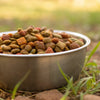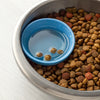Is Salmon Dry Food Good for Dogs? Understanding the Benefits and Considerations
- Houndsy
Table of Contents
- Introduction
- What Makes Salmon a Beneficial Ingredient for Dogs?
- How to Incorporate Salmon into Your Dog's Diet
- Potential Risks and Considerations
- The Best Ways to Prepare Salmon for Your Dog
- Conclusion
Introduction
As devoted pet owners, we often find ourselves pondering the best dietary choices for our furry companions. Did you know that approximately 40% of dogs are considered overweight? This statistic highlights the importance of a balanced diet tailored to our pets' unique nutritional needs. One ingredient that has gained traction among pet parents is salmon, known for its rich nutrient profile and health benefits. But is salmon dry food good for dogs? In this blog post, we will explore the advantages and considerations of incorporating salmon into our dogs' diets, focusing on its nutritional benefits, preparation methods, and the potential for food allergies.
By the end of this article, we aim to provide a comprehensive understanding of why salmon is an excellent choice for many dogs, while also addressing important safety measures and preparation tips. So, let’s dive in and ensure our beloved pets enjoy the healthiest and tastiest meals possible!
What Makes Salmon a Beneficial Ingredient for Dogs?
Salmon is not only a popular choice for human diets but also a fantastic ingredient for canine nutrition. Here are several reasons why salmon deserves a place in our dogs' meals:
1. Rich in Omega-3 Fatty Acids
One of the standout features of salmon is its high content of omega-3 fatty acids, particularly EPA (eicosapentaenoic acid) and DHA (docosahexaenoic acid). These essential fatty acids can have profound benefits for our dogs, including:
- Improving Coat Health: Omega-3s help maintain a healthy, shiny coat and reduce shedding.
- Reducing Inflammation: These fatty acids can alleviate joint pain and stiffness, making them especially beneficial for older dogs or those with arthritis.
- Supporting Skin Health: Regular consumption of salmon can combat dry and itchy skin, promoting overall skin health.
2. High-Quality Protein Source
Salmon is an excellent source of high-quality protein, which is essential for muscle growth, repair, and overall energy levels. Unlike some common protein sources that may trigger allergies in dogs, salmon is often well-tolerated, making it a suitable alternative for dogs with food sensitivities.
3. Nutrient-Dense Profile
Salmon is packed with essential vitamins and minerals, including:
- Vitamin D: Essential for bone health and regulating calcium levels.
- B Vitamins: Crucial for energy metabolism and overall cellular health.
- Selenium: A powerful antioxidant that supports immune function.
4. Supports Cognitive Function
Research indicates that the DHA in salmon supports brain health and cognitive function, particularly in puppies and senior dogs. This nutrient is vital for the development of the nervous system in young dogs and can help slow cognitive decline in older pets.
5. Reduces Risk of Food Allergies
Many dogs experience food allergies related to common proteins like chicken or beef. Introducing salmon as a novel protein source can help alleviate symptoms such as itching and gastrointestinal upset in sensitive dogs.
How to Incorporate Salmon into Your Dog's Diet
Adding salmon to your dog's diet can be done in various ways, from raw fish to kibble enriched with salmon. Here are some considerations:
1. Choose High-Quality Commercial Dog Food
If you prefer convenience, high-quality dog food that includes salmon as a primary ingredient can be an excellent choice. Look for brands that prioritize sustainability and use responsibly sourced salmon. The Houndsy Kibble Dispenser can help you serve the right portions conveniently. Check it out here.
2. Fresh Salmon Preparations
If you opt to prepare fresh salmon for your dog, ensure that you follow these safety guidelines:
- Cook Thoroughly: Never feed your dog raw or undercooked salmon, as it can contain harmful parasites that lead to salmon poisoning disease.
- Remove Bones: Always check for and remove any bones before serving to avoid choking hazards.
- No Seasonings: Cook the salmon without oil, salt, or seasonings, as these can be harmful to dogs.
3. Canned Salmon
Canned salmon can also be a convenient option, but ensure that it is packed in water without added salt or other ingredients. This provides a tasty treat without the risk of harmful additives.
Potential Risks and Considerations
While salmon offers numerous health benefits, there are some considerations to keep in mind:
1. Allergies and Sensitivities
Although many dogs can enjoy salmon without issues, some may develop allergies. Monitor your dog for any signs of adverse reactions, such as itching, gastrointestinal upset, or changes in behavior after introducing salmon to their diet.
2. Portion Control
Salmon should be fed in moderation. Overfeeding can lead to weight gain and potential health issues, such as pancreatitis. A good rule of thumb is to incorporate salmon as a treat or part of a balanced diet rather than the primary protein source.
3. Parasite Risk
As mentioned earlier, raw salmon can harbor harmful parasites. Always ensure that the salmon is cooked thoroughly to eliminate this risk.
The Best Ways to Prepare Salmon for Your Dog
When preparing salmon for your dog, consider these methods to ensure a safe and nutritious meal:
1. Baking or Grilling
Baking or grilling salmon without any added oils or seasonings is one of the healthiest ways to prepare it. This method retains the fish's nutritional content while making it easy to serve.
2. Poaching
Poaching is a gentle cooking method that keeps the fish moist and flavorful. Simply simmer salmon in water until cooked through.
3. Canned Salmon
If you opt for canned salmon, simply drain the water and serve it as is. This is a quick and easy way to provide your dog with the benefits of salmon.
Conclusion
Incorporating salmon into our dogs' diets can be a great way to enhance their health and well-being. From its rich source of omega-3 fatty acids to its high-quality protein content, salmon can offer numerous benefits for our furry friends. However, it’s essential to be mindful of preparation methods, portion sizes, and potential allergies.
As we strive to provide the best for our pets, consider exploring the Houndsy Kibble Dispenser, designed to simplify and elevate the dog-feeding experience. With its combination of functionality and modern design, it’s an excellent addition to your pet care routine. Discover more about our Kibble Dispenser here.
FAQ
1. Can dogs eat raw salmon?
No, raw salmon can contain harmful parasites that can cause serious health issues. Always cook salmon thoroughly before serving it to your dog.
2. How often can I feed my dog salmon?
Salmon should be fed in moderation. It’s best to limit salmon intake to a few times a week, ensuring it is part of a balanced diet.
3. What are the signs of a salmon allergy in dogs?
Signs may include itching, gastrointestinal upset, or skin rashes. If you notice these symptoms, consult your veterinarian.
4. Is canned salmon safe for dogs?
Yes, canned salmon can be safe for dogs if it’s packed in water without added salt or seasonings. Always check the label before serving.
5. What should I do if my dog refuses to eat salmon?
If your dog is hesitant to eat salmon, try mixing it with their regular food or offering it in smaller portions. If they continue to refuse it, consult your veterinarian for alternative protein sources.












